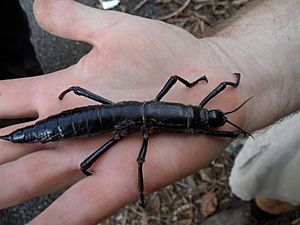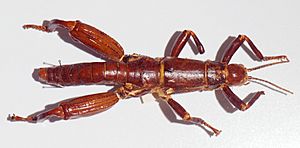Tree Lobster facts for kids
Quick facts for kids Tree Lobster |
|
|---|---|
 |
|
| Live specimen | |
| Conservation status | |
| Scientific classification | |
| Kingdom: | |
| Phylum: | |
| Class: | |
| Order: | |
| Family: | |
| Genus: |
Dryococelus
|
| Species: |
D. australis
|
| Binomial name | |
| Dryococelus australis (Montrouzier, 1855)
|
|
The Dryococelus australis, also known as the Lord Howe Island stick insect or tree lobster, is a type of stick insect. It lives on the Lord Howe Island Group in Australia. For many years, people thought this insect was completely gone from the world by 1920. But in 2001, it was amazingly found again!
This stick insect no longer lives on its main home, Lord Howe Island. It is now found only on a tiny rocky island called Ball's Pyramid. This small island is about 23 kilometers (14 miles) southeast of Lord Howe Island. Because so few were found, it was called "the rarest insect in the world." The rediscovered group had only 24 insects living under one small plant.
Contents
What Does the Lord Howe Island Stick Insect Look Like?
Adult Lord Howe Island stick insects can grow up to 20 centimeters (8 inches) long. They can weigh about 25 grams (0.9 ounces). Male insects are about 25% smaller than females. These insects have a long, oval shape and strong legs. Males have thicker thighs than females.
Unlike most other stick insects, these insects do not have wings. But they can run very fast!
How Do Lord Howe Island Stick Insects Behave?
The way these stick insects behave is quite special for an insect. Sometimes, a male and female will form a pair and stay together. The females lay their eggs while hanging upside down from tree branches. It can take up to nine months for the eggs to hatch.
When the baby insects, called nymphs, first hatch, they are bright green. They are also active during the day. As they grow older, they turn black and become active mostly at night.
Reproduction and Survival
These insects can reproduce even without a male present. This is called parthenogenesis. This special ability helped the species survive when their numbers were very low.
History and Conservation Efforts
Lord Howe Island stick insects used to be very common on Lord Howe Island. People even used them as bait for fishing. But then, in 1918, a supply ship called the SS Makambo got stuck on the island. This accident allowed black rats to get onto the island. After 1920, no stick insects could be found, and people thought they were extinct.
The Rediscovery of the Stick Insect
In 1964, some climbers visited Ball's Pyramid. This is a tall, rocky island near Lord Howe Island. They found a dead Lord Howe Island stick insect there. Over the next few years, more dead insects were found by climbers. But no one could find any living ones.
In 2001, two Australian scientists, David Priddel and Nicholas Carlile, thought there might be enough plants on Ball's Pyramid for the insects to live. They went to the island with two helpers. They climbed up a grassy slope but only found crickets. On their way down, they saw large insect droppings under a single Melaleuca shrub. This plant was growing in a crack about 100 meters (330 feet) above the ocean.
The scientists realized they needed to come back at night. This is when the insects are active. Carlile returned with a local park ranger, Dean Hiscox. They climbed back up the slopes with a camera and flashlights. They found a small group of 24 living insects. These insects were hiding under the Melaleuca shrub among lots of dead plant material.
Bringing Them Back: Breeding Programs
In 2003, a research team went back to Ball's Pyramid. They carefully collected two pairs of stick insects for breeding. One pair went to a private breeder in Sydney. The other pair went to the Melbourne Zoo. At first, it was hard to get them to breed. But soon, the insects successfully reproduced in captivity at the Melbourne Zoo.
The main goal was to create a large group of these insects. Then, they could be brought back to Lord Howe Island. This could happen if a plan to remove the invasive rats from the island was successful.
By 2006, there were about 50 insects in the captive group. Thousands more eggs were waiting to hatch. In 2008, when famous scientist Jane Goodall visited the zoo, the population had grown a lot. There were 11,376 eggs and 700 living insects. Soon after, 20 of these insects were sent back to a special safe area on Lord Howe Island. By April 2012, the Melbourne Zoo had bred over 9,000 insects. This included 1,000 adult insects and 20,000 eggs.
New Discoveries and Global Efforts
In 2014, some climbers found live stick insects near the top of Ball's Pyramid. They were in a thick patch of sedge plants at 500 meters (1,640 feet) high. This showed that the insects lived in more places on the island than thought. It also showed they could eat plants other than Melaleuca howeana.
By early 2016, Melbourne Zoo had hatched 13,000 eggs. They also sent eggs to other zoos around the world. These included the Bristol Zoo in England, the San Diego Zoo in the United States, and the Toronto Zoo in Canada. This helped create backup groups of the insects in case something happened to the main group.
A study in 2017 looked at the DNA of the stick insects from Ball's Pyramid. They compared it to old museum samples from Lord Howe Island. The study confirmed that both groups were the same species. This was true even though they looked a little different. The study also found that the insect's DNA is very large.
See also
 In Spanish: Insecto palo para niños
In Spanish: Insecto palo para niños



